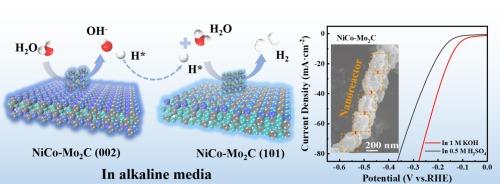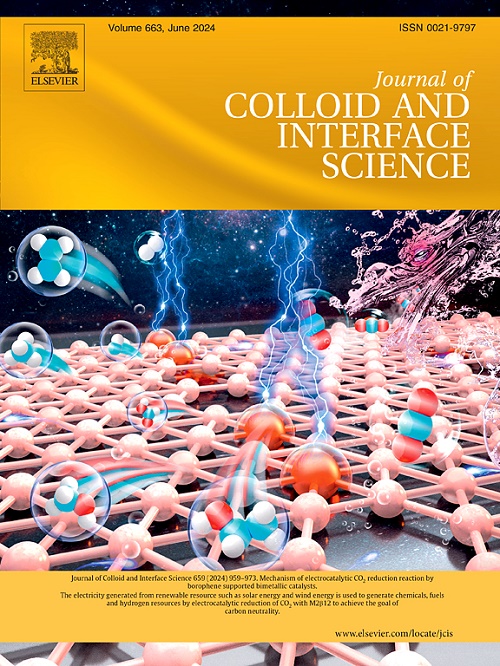具有双金属调制和晶面协同作用的 NiCo-Mo2C 串联纳米反应器中的高效电催化氢气进化。
IF 9.4
1区 化学
Q1 CHEMISTRY, PHYSICAL
引用次数: 0
摘要
Mo2C 的电子结构与铂的电子结构非常相似,有望成为非贵金属电催化氢进化反应 (HER) 的催化剂。本研究利用高增益晶体管级联放大器的概念,设计并合成了镍和钴双金属掺杂的 Mo2C(NiCo-Mo2C)串联纳米反应器。在 NiCo-Mo2C 材料中,Mo2C 棒上的每个单体层都是一个独立的电催化纳米反应器,棒支持这些单元的串联配置。NiCo-Mo2C 界面上 Ni 和 Co 的联合调制增加了 Mo 周围的电子云密度,并使 d 带中心负向移动,从而有效降低了 Mo-H* 的结合能。NiCo-Mo2C(101)和(002)晶面之间的协同作用促进了水的解离和 Mo 位点上 H* 的解吸。在 1 M KOH 和 0.5 M H2SO4 中,10 mA-cm-2 (η10) 的低过电位值分别为 129 mV 和 180 mV,Tafel 斜率分别为 84 mV-dec-1 和 85 mV-dec-1,这表明这种串联配置的多催化单元实现了更强的氢进化能力。通过双金属调制、晶面协同作用和串联结构,这项研究提出了一种优化 HER 动力学的新方法,为开发高效的非贵金属电催化剂提供了一种宝贵的策略。本文章由计算机程序翻译,如有差异,请以英文原文为准。

High-efficiency electrocatalytic hydrogen evolution in NiCo-Mo2C tandem nanoreactors with bimetallic modulation and crystal plane synergy
Mo2C, with an electronic structure closely resembling that of Pt, holds significant promise as a catalyst for nonprecious metal-based electrocatalytic hydrogen evolution reactions (HER). This study presents the design and synthesis of Ni and Co bimetallic-doped Mo2C (NiCo-Mo2C) tandem nanoreactors, engineered by leveraging the concept of a high-gain transistor cascade amplifier. In NiCo-Mo2C material, each monomer layer on Mo2C rod functions as an individual electrocatalytic nanoreactor, with the rod supporting a tandem configuration of these units. The combined modulation of Ni and Co at NiCo-Mo2C interface increases the electron cloud density around Mo and shifts the d-band center negatively, effectively reducing Mo–H* binding energy. The synergy between NiCo-Mo2C (1 0 1) and (0 0 2) crystal planes facilitates both water dissociation and H* desorption from Mo sites. This tandem configuration of multicatalytic units achieves enhanced hydrogen evolution, demonstrated by the low overpotential at 10 mA·cm−2 (η10) values of 129 mV and 180 mV and Tafel slopes of 84 mV·dec−1 and 85 mV·dec−1 in 1 M KOH and 0.5 M H2SO4, respectively. Through bimetallic modulation, crystal plane synergy, and tandem structuring, this work advances a novel approach to optimizing HER kinetics, presenting a valuable strategy for developing highly efficient, nonprecious metal-based electrocatalysts.
求助全文
通过发布文献求助,成功后即可免费获取论文全文。
去求助
来源期刊
CiteScore
16.10
自引率
7.10%
发文量
2568
审稿时长
2 months
期刊介绍:
The Journal of Colloid and Interface Science publishes original research findings on the fundamental principles of colloid and interface science, as well as innovative applications in various fields. The criteria for publication include impact, quality, novelty, and originality.
Emphasis:
The journal emphasizes fundamental scientific innovation within the following categories:
A.Colloidal Materials and Nanomaterials
B.Soft Colloidal and Self-Assembly Systems
C.Adsorption, Catalysis, and Electrochemistry
D.Interfacial Processes, Capillarity, and Wetting
E.Biomaterials and Nanomedicine
F.Energy Conversion and Storage, and Environmental Technologies

 求助内容:
求助内容: 应助结果提醒方式:
应助结果提醒方式:


